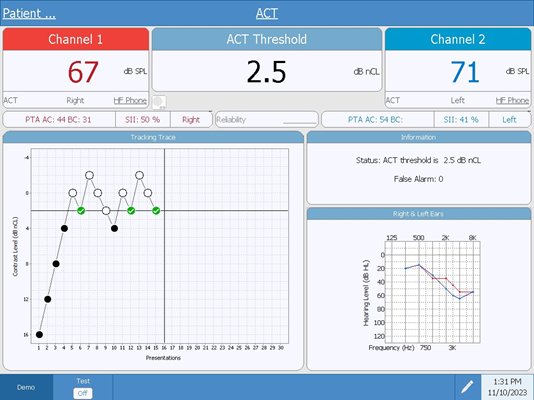ACT Test
Audiometry Guides
The Audible Contrast Threshold (ACT) test is a new clinical test that measures binaural spectro-temporal modulation sensitivity to quickly quantify a person’s real-world ability to understand speech-in-noise. This ACT value predicts the patient’s aided speech-in-noise ability and when compared to normative data, guides the provider with recommendations for the hearing aid fitting.

Presentation Levels
The intensity level of the non-modulated noise is based on the patient’s pure tone thresholds at 250-4000 Hz for each ear and is automatically determined by the AudioStar Pro. The noise level will vary depending on the degree and configuration of the patient’s hearing loss and ensures that the ACT stimuli will be audible for all patients.
Test Instructions
“This test will help determine how well you are able to hear in noisy situations. During this test you will hear constant noise through the headphones. Occasionally you will hear a siren-like sound. As soon as you hear this siren sound, press the button.
Here are some examples of sounds that you will hear. This is the constant noise that you will hear.”
[PLAY NOISE]
“This is the siren sound which you will hear occasionally. When you hear this sound press the button.”
[PLAY STIM]
“During the test you will hear the siren and the noise mixed together. Remember to press the button only when you hear the siren.”
[PLAY COMBINED]
“This test will only take a few minutes.”
Test Procedures
- On the AudioStar Pro, press the MORE button and select ACT to launch the test.
- Patient instructions will appear and include the ability to demonstrate the noise, the stimulus, and the noise + stimulus so the patient has a clear understanding of the task.
- Once the test has started, the noise is presented to the patient, but the clinician must present the signal by pressing the present bar.
- The audiometer scores the patient’s response on the Tracking Trace graph.
- The tester should increase and decrease the contrast level depending on the patient's response like the procedure for pure tone audiometry.
Interpreting Results
The most effective way to use the ACT threshold is in the hearing aid fittings. The ACT value will range from -4 dB nCL to 16 dB nCL. The lower the ACT value, the better the patient will be able to hear speech in noise. While the higher the ACT value, the more difficulty they will have hearing when background noise is present.
The following guide can be used to optimize the adaptive features of a hearing aid such as noise reduction and directionality.
| ACT Score dB nCL |
Contrast Loss |
Predicted Aided Speech-In-Noise Performance |
Fitting Advice |
| -4 to 4 |
Normal
|
Normal range
|
Adaptive features set to minimum level - help preserve natural sound in all environments.
|
| 4 to 7 |
Mild
|
Mildly poorer than normal
|
Adaptive features set to slightly higher than minimum level - help preserve natural sound and improve speech understanding in the noisiest environment.
|
| 7 to 10 |
Moderate
|
Moderately poorer than normal
|
Adaptive features set to slightly lower than the maximum level - help balance speech understanding while maintaining natural sound in moderately noisy environments.
|
| 10 to 16 |
Severe
|
Severely poorer than normal
|
Adaptive features set to maximum level - help prioritize speech understanding in even the least noisy environments. Also consider streaming devices and communication training.
|